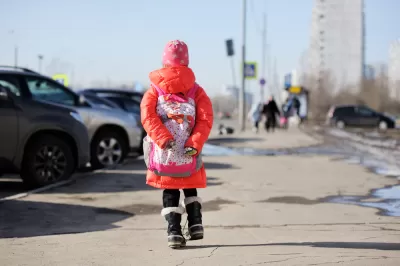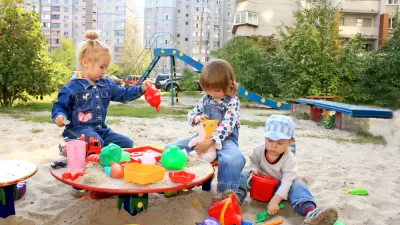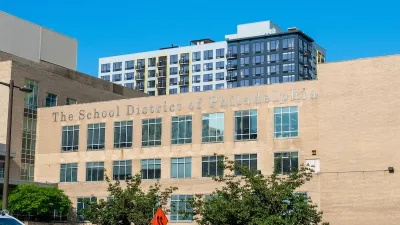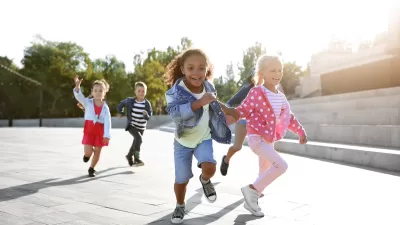A city that fosters the mental and physical health of children is safer for everyone. Six key planning and design considerations promote the well-being of the city's youngest residents.

We can use urban planning and design to better protect children. "It’s estimated that up to 500 children die daily in road crashes around the world; thousands more incur injuries and psychological trauma from collisions with vehicles that can affect them for years," write Nikita Luke, Rohit Tak, Ariadne Samios, and Claudia Adriazola-Steil.
Their article offers six ways cities can change the lives of kids for the better—ideas that go beyond adding playgrounds and aims to consider children's needs in decisionmaking processes regarding public policy.
The six improvements identified by the authors promote enhanced mental and physical health in young people: increase accessible green space, ensure safe pedestrian infrastructure, implement low-speed zones, include car-free streets, consider size, and create clean air zones.
But the benefits experienced by children would also be felt by adults. The article quotes Mayor Enrique Peñalosa of Bogotá in describing children as "a kind of indicator species." If urban planners and designers are able to build a city that promotes success for kids, everyone will experience success in cities.
"As cities and national governments reset after the coronavirus and ponder investments that will hasten a return to economic and social vibrance, incorporating the unique perspectives of children can help create more inclusive, healthier, livable cities. It’s time for cities to start thinking proactively and long-term about how best to serve all residents, including their youngest" write the authors.
FULL STORY: What Makes a Child-Friendly City? Redesigning Safer and Healthier Urban Spaces for Young People

Alabama: Trump Terminates Settlements for Black Communities Harmed By Raw Sewage
Trump deemed the landmark civil rights agreement “illegal DEI and environmental justice policy.”

Study: Maui’s Plan to Convert Vacation Rentals to Long-Term Housing Could Cause Nearly $1 Billion Economic Loss
The plan would reduce visitor accommodation by 25% resulting in 1,900 jobs lost.

Planetizen Federal Action Tracker
A weekly monitor of how Trump’s orders and actions are impacting planners and planning in America.

Waymo Gets Permission to Map SF’s Market Street
If allowed to operate on the traffic-restricted street, Waymo’s autonomous taxis would have a leg up over ride-hailing competitors — and counter the city’s efforts to grow bike and pedestrian on the thoroughfare.

Parklet Symposium Highlights the Success of Shared Spaces
Parklets got a boost during the Covid-19 pandemic, when the concept was translated to outdoor dining programs that offered restaurants a lifeline during the shutdown.

Federal Homelessness Agency Places Entire Staff on Leave
The U.S. Interagency Council on Homelessness is the only federal agency dedicated to preventing and ending homelessness.
Urban Design for Planners 1: Software Tools
This six-course series explores essential urban design concepts using open source software and equips planners with the tools they need to participate fully in the urban design process.
Planning for Universal Design
Learn the tools for implementing Universal Design in planning regulations.
Caltrans
Smith Gee Studio
Institute for Housing and Urban Development Studies (IHS)
City of Grandview
Harvard GSD Executive Education
Toledo-Lucas County Plan Commissions
Salt Lake City
NYU Wagner Graduate School of Public Service





























